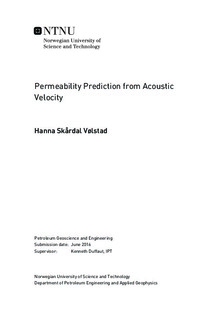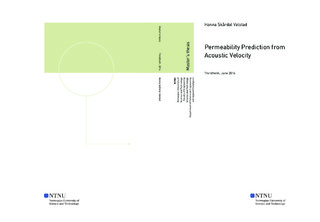| dc.description.abstract | Permeability is estimated in the middle Jurassic Garn Fm. in the Haltenbanken area in the Norwegian Sea by combining the Kozeny-Carman model for permeability estimation with Raymer s model for porosity estimation. The Kozeny-Carman model is derived for a tube-like pore-geometry and extended to yield for a granular media.
The porosity applied into the Kozeny-Carman model is estimated by Raymer s model from different sources of velocity data, such as fluid corrected sonic velocity, check-shots and seismic velocities.
The measured velocity and porosity data in the cleanest parts of the Garn Fm. follows the Raymer model, so the Raymer-relation is considered valid in this area. The scattering of the data around the Raymer-curve tends to plot more below than above the Raymer-line. This trend increase when the porosity decrease, leading to a gradual over-prediction of porosity. Hence, giving an overestimation in the permeability.
The permeability estimations are compared against log-derived permeabilities calibrated towards core measurements, referred to as core calibrated permeability. The permeability estimations show that porosity obtained from sonic velocity gives better permeability results than permeability estimates from seismic velocity derived porosities. However, when the seismic velocity is calibrated against check-shots and the effect of anisotropy is reduced to fit time-depth curves, the vertical seismic interval velocities in Garn are significantly improved, consequently providing better porosity and permeability estimates.
The results show that this model is able to translate velocity into estimates for porosity and permeability. The precision in the velocity is the most important factor in this analysis, so the challenge with applying seismic velocities is that the seismic signal are low frequent and affected by smoothing effects. Hence, the seismic velocity only perceive the slowly varying velocity trends as a response to lithology changes in the subsurface. | |

